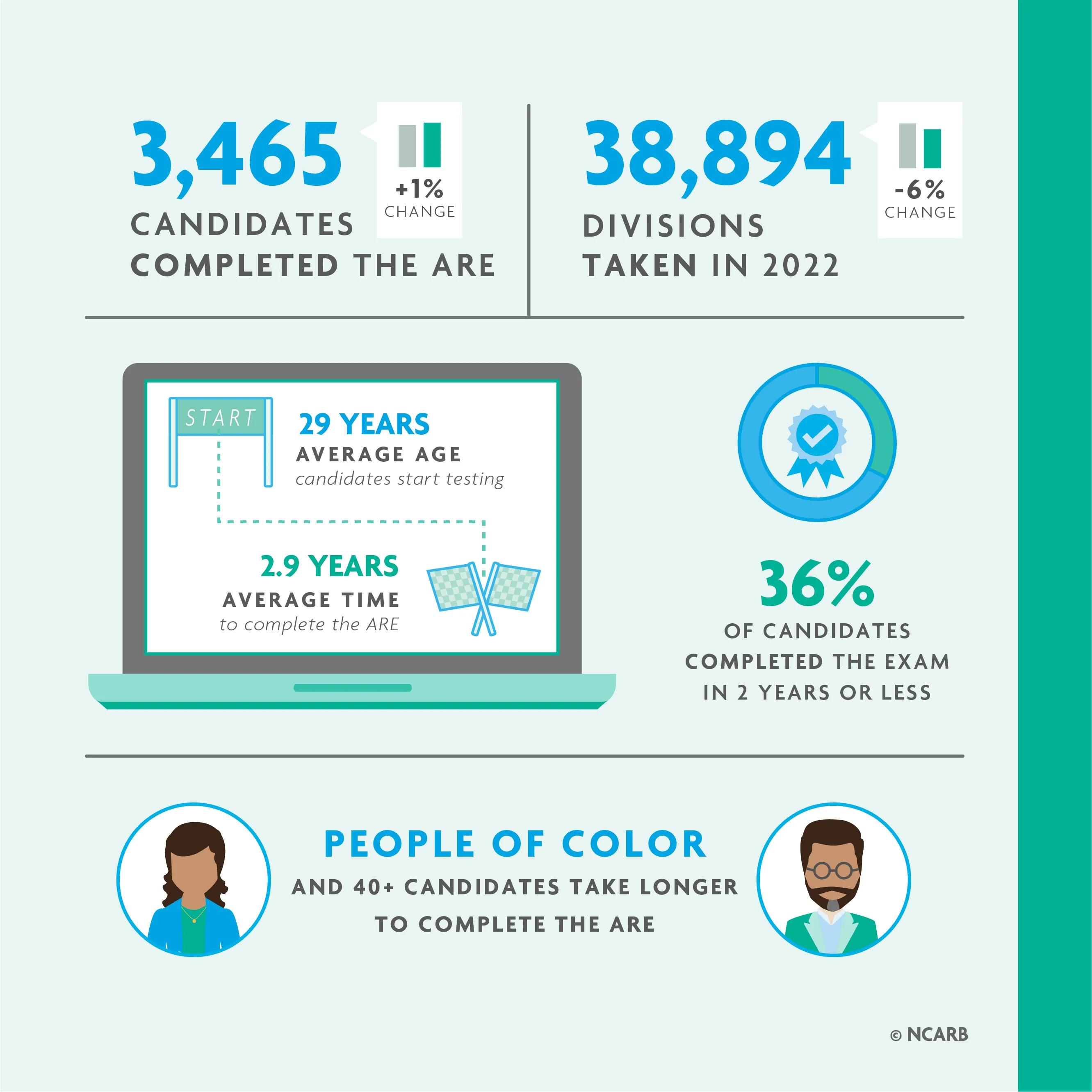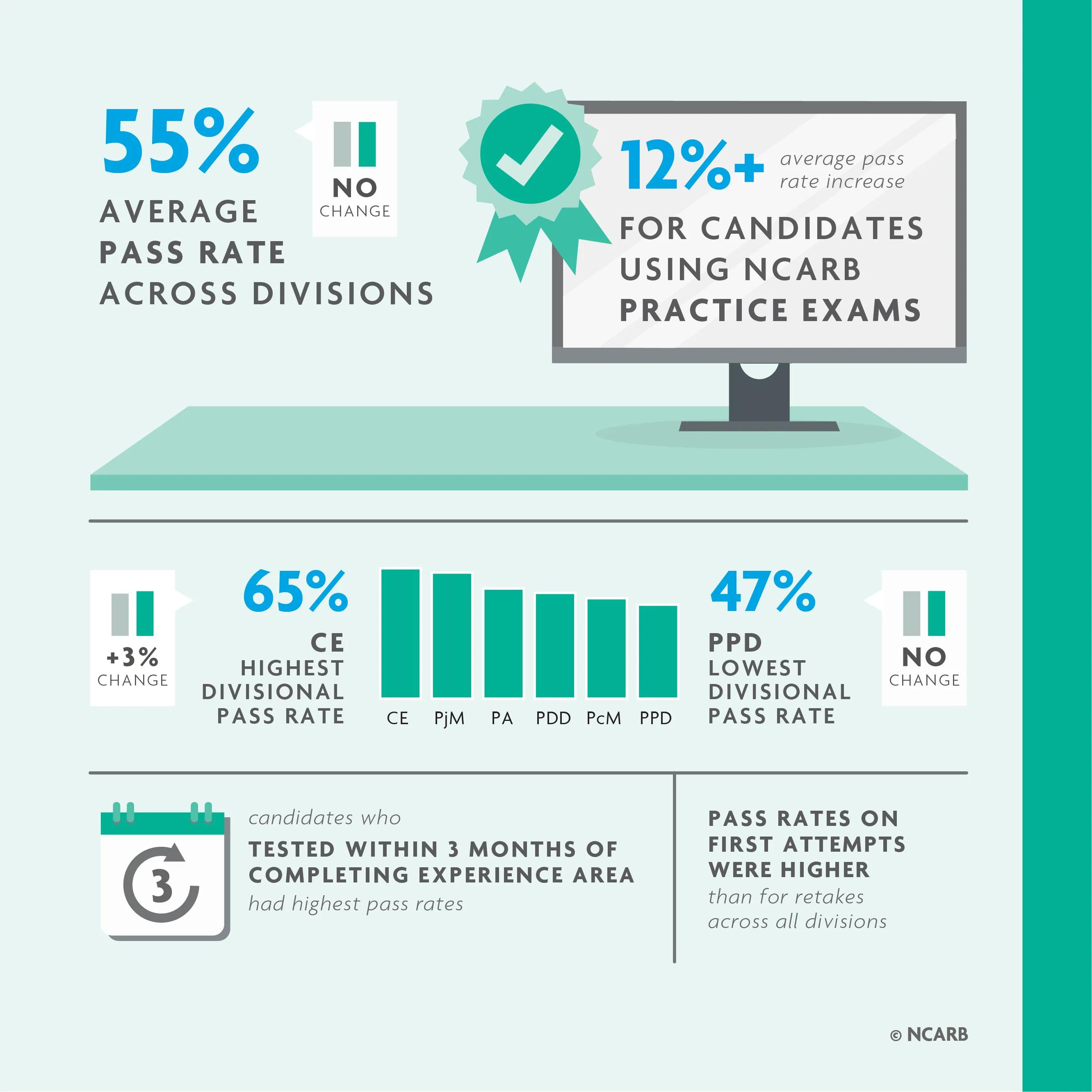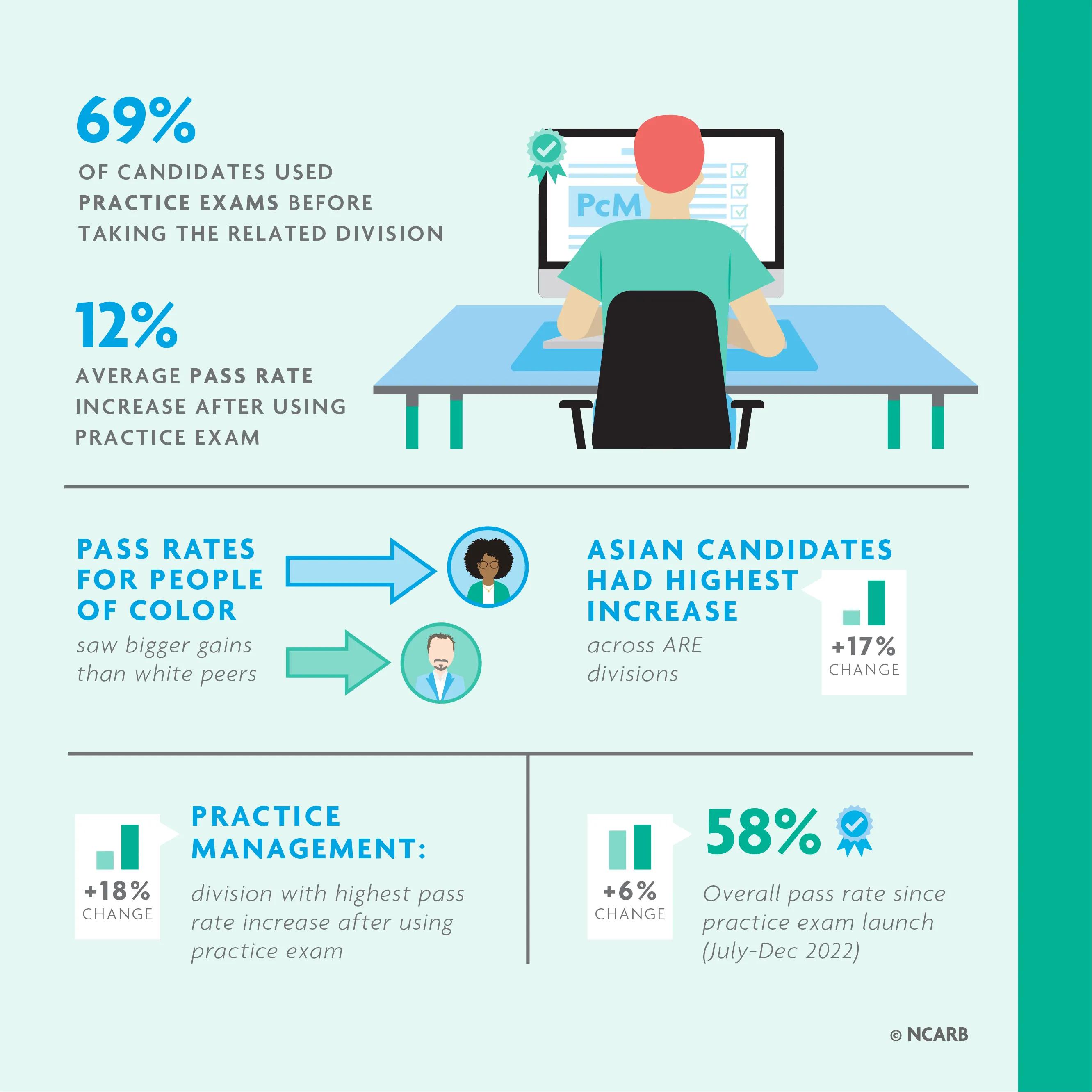
Required by all 55 U.S. jurisdictions, the Architect Registration Examination® (ARE®) 5.0 is a six-part exam taken by candidates seeking architectural licensure. Over 3,400 candidates completed the ARE in 2022, and the average candidate took 2.9 years to complete all six exams.

NCARB implemented a variety of changes to the ARE in 2022, including moving exam delivery vendors from Prometric to PSI, launching new English as a Second Language (ESL) accommodations for testers whose first language is not English, and launching free, full-length practice exams for all six ARE divisions. With the migration to PSI in June 2022, NCARB also removed exam rescheduling fees, which led to significantly fewer exam deliveries in the second half of the year.
On all divisions of the ARE and for all demographic groups, pass rates increased significantly for candidates who used NCARB’s free, full-length practice exams. However, because more candidates tested in the first half of the year—prior to the launch of the practice exams—overall ARE pass rates held steady for the year.
The number of candidates completing the national licensing exam remained relatively steady in 2022, increasing by just 1% to 3,465. This stall in exam completions is likely due to the removal of exam rescheduling fees in June 2022. With the ability to reschedule for free, candidates began rescheduling exams at a higher rate during the second half of the year, leading to a decrease in exam deliveries.
The dip in exam completions seen in 2020 resulted from test center closures near the initial onset of COVID-19 and limited testing availability throughout the remainder of the year.
The average candidate who completed the ARE in 2022 took 2.9 years to do so, three months longer than in 2021. This increase is most likely tied to the ongoing impact of COVID-19, which caused many candidates to delay their testing plans in 2020-2021, as well as the increase in exam rescheduling seen in the second half of 2022.
As candidates continue to enjoy the flexibility to reschedule their exam appointments as needed, the time needed to complete the ARE may continue to increase in the years ahead.
Similar to 2021 data, slightly more than a third (36%) of ARE candidates who finished the exam in 2022 did so in two years or less. 2022 represents the first year since 2017 that the proportion of candidates completing the exam in under two years has not decreased.
However, the number of candidates who took four or more years to complete the exam increased by 4 percentage points to 37%.
Most candidates of color took longer to complete the exam than their white peers. For example, over half of Black or African American candidates (54%) and Hispanic or Latino candidates (51%) took four or more years to complete the ARE. These two racial and ethnic groups also have the smallest proportion of testers finishing the exam in under two years (27%).
At 38% and 35%, white and Asian candidates were the most likely to complete the exam in under two years.
In 2022, men and women completed the ARE in similar time frames, with men two percentage points more likely than women to complete the ARE in under two years (37% vs. 35%). For both men and women, 63% of candidates completed the exam in four or less years.
When viewing the data for different age groups, younger candidates were much more likely to complete the exam in a shorter time frame, with 92% of candidates aged 18-29 finishing in four or less years. However, 64% of candidates aged 40 or older took four or more years to complete the ARE.
The number of exams administered fell slightly from 40,944 in 2021 to 38,894 in 2022—a decrease of 6%. Of the exams administered in 2022, over a third (14,468) were retakes, and the remaining 25,714 were first attempts.
The slight decrease in overall exam administrations was likely a result of NCARB’s decision to remove exam rescheduling fees in June 2022, which led to fewer exam deliveries for the latter half of the year.
Of the nearly 39,000 exams taken in 2022, approximately 19% were for the Project Planning & Design (PPD) division, including 3,847 first attempts and 3,675 retakes. The Project Planning & Design (PPD) division also saw the largest proportion of retakes (49%), closely followed by Project Development & Documentation (PDD) at 42%.
Construction & Evaluation (CE) and Project Management (PjM) saw the lowest proportion of retakes in 2022, reflecting the higher initial pass rates seen for these divisions.
After an uncharacteristic drop in 2021, Construction & Evaluation (CE) had the highest divisional pass rate again at 65%, increasing by 3 percentage points from 2021 to 2022. CE is closely followed by the Project Management division, which had a pass rate of 63% (no change from 2021).
Other than CE, the only other division to see an increase in pass rates was Programming & Analysis (PA), which increased by 3 percentage points, up to 55%.
Project Planning & Design continued to have the lowest pass rate of the six ARE divisions, unchanged at 47%. Pass rates for Project Development & Documentation also saw no change at 53%. Practice Management was the only division that had a decrease in pass rates, dropping from 53% in 2021 to 50% in 2022.

How to use this chart: By selecting demographic characteristics from the top right menus, you can filter the chart to view only pass rates for the selected gender/race/ethnicity. For example, to view pass rates for Black or African American women, select “Female” from the gender menu and “Black or African American” from the race/ethnicity menu.
White men had the highest pass rate on every ARE 5.0 division in 2022, often by significant margins when compared to their peers of other races, ethnicities, and genders (with one exception: white women were slightly more likely to pass PcM). The average pass rate of white men on each ARE division exceeded the national average by 6-16 percentage points, depending on the division.
Overall, women achieved lower pass rates compared to men of the same race or ethnicity—although not always across all divisions or for all demographic groups. When viewed solely by gender, male candidates outperformed female candidates on all ARE divisions except PcM, where women were 2 percentage points more likely to pass than men. Additionally, Black women outperformed their male counterparts on four out of six divisions (CE, PA, PcM, PjM), and Hispanic women outperformed their male counterparts on three divisions (CE, PcM, PjM).
However, the greatest disparities between demographics groups were seen between Black or African American men and their white counterparts, with gaps of 30-37 percentage points for each division. White men’s pass rates were often double (or more than double in the case of PcM, PDD, PPD) the pass rates of Black or African American men.
NCARB is working to better understand the various factors that contribute to demographic disparities on the ARE. NCARB is exploring how factors such as question type, content area, language, readability, and overall progress along the path to licensure may impact candidate performance.
A review of divisional pass rates over time illustrates how candidate performance across all six divisions has been moving toward a more consistent pass rate in recent years. However, the performance gap between divisions widened slightly in 2022, with a spread of 18 points between the division with the highest pass rate (CE) and the division with the lowest pass rate (PPD)—2 points larger than in 2021.
NCARB’s staff, expert volunteers, and testing consultants continuously evaluate ARE 5.0 results to ensure that the exam is fair, valid, and accurately measures candidate competency.
For each ARE 5.0 division, pass rates for first attempts were higher than for subsequent retakes on that same division. The most significant gap between first attempts and retakes was seen in the Programming & Analysis division, with an 18 percentage point difference.
Project Planning & Design had the smallest gap between first attempts (51%) and retakes (43%) —an 8 percentage point difference.
Across all six ARE divisions, pass rates increased by 7-18 percentage points for candidates who used NCARB’s practice exams.
Pass rates for the Practice Management (PcM) division saw the largest increase after the practice exam launch, with pass rates jumping nearly 18 percentage points from 41% to 58%. The Programming & Analysis (PA) division saw a lower, though still significant, increase in pass rates, rising 7 percentage points.

The increase seen for candidates using NCARB’s free practice exams was even higher for some demographic groups: Asian or Asian American, Black or African American, and Hispanic or Latino candidates using the practice exams saw a larger impact on pass rates compared to white candidates.
Asian or Asian American and Black or African American candidates saw a 17 percentage point increase in pass rates compared to those who don’t use the practice exams—the largest average increase seen across all racial and ethnic groups.
Meanwhile, men and women were equally impacted by use of the practice exams, with both groups seeing a 13 percentage point increase in pass rates compared to candidates who didn’t use the practice exams.
Of the candidates who completed the national licensing exam in 2022, 59% took at least one ARE division prior to completing the experience program—1 percentage point more than in 2021.
The proportion of candidates overlapping the AXP and ARE has been slowly declining since ARE 5.0’s launch in 2016, which aligned the AXP’s practice areas with the exam divisions.
The six experience areas of the AXP align with the six divisions of ARE 5.0. On average, candidates who took an ARE division within three months of completing the related experience area saw the highest pass rates.
For example, candidates who took the Project Planning and Design (PPD) division within three months of completing the corresponding experience area saw a pass rate of 67%. However, candidates who hadn’t yet started the PPD experience area before taking the division had a 40% pass rate—27 percentage points lower.
Note: Most licensure candidates complete some or all of an experience area before testing.
